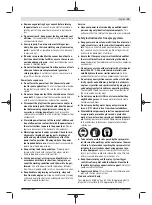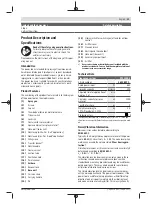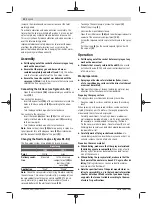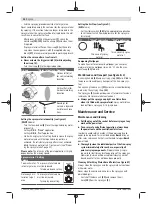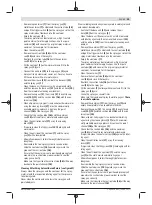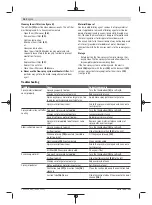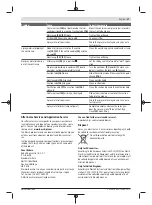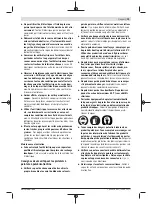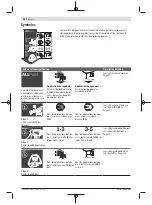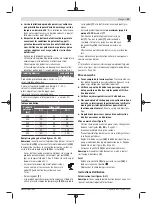
22
| English
increase the vibration and noise emissions over the total
working period.
To estimate vibration and noise emissions accurately, the
times when the tool is switched off or when it is running but
not actually being used should also be taken into account.
This may significantly reduce vibration and noise emissions
over the total working period.
Implement additional safety measures to protect the oper-
ator from the effects of vibration, such as servicing the
power tool and application tools, keeping their hands warm,
and organising workflows correctly.
Assembly
u
Pull the plug out of the socket before carrying out any
work on the power tool.
u
Ensure that the spray gun and base unit are as-
sembled completely and with all seals
. Only this will en-
sure the function and safety of the fine-spray system.
u
Ensure that a nozzle cap that was delivered with the
spray gun is fitted.
Only this will ensure the function and
safety of the fine-spray system.
Connecting the Air Hose (see figures A1–A3)
– Open the elastic band
(28)
and completely unwind the air
hose
(19)
.
Connecting the base unit:
– Insert a bayonet lock
(20)
of the air hose securely into the
holes in the base unit port
(29)
according to the arrow
marks.
– Turn the bayonet lock a quarter turn clockwise.
Connecting to the spray gun:
– Insert the second bayonet lock
(20)
of the air hose se-
curely into the holes in the spray gun port
(9)
according
to the arrow marks.
– Turn the bayonet lock a quarter turn clockwise.
Note:
Remove the air hose
(19)
before pouring in spray ma-
terial (quarter turn of the bayonet lock
(20)
anticlockwise;
pull the bayonet lock
(20)
out of the port
(9)
).
Changing the Nozzle Cap (see figures B1–B2)
The fine-spray system is supplied with two nozzle caps:
Nozzle cap
(10)
(11)
Paint
White
Grey
Delivery condi-
tion
Mounted
In the accessory
compartment
(30)
un-
der the air filter
cover
(26)
Application
"Wall"
"Wood"
Note:
Check the spray material by stirring it before selecting
the nozzle cap. Thin-viscosity material (e.g. wood paint) can
be sprayed better with the grey nozzle cap
(11)
. Thick-vis-
cosity material (e.g. wood lacquer or wall paint) can be
sprayed better with the white nozzle cap
(10)
.
– To change the nozzle cap, unscrew the cap nut
(3)
.
– Pull off the air cap
(2)
.
– Unscrew the mounted nozzle cap.
– Open the air filter cover
(26)
and take the required nozzle
cap out of the accessory compartment
(30)
.
– Screw the required nozzle cap into the thread in the spray
gun.
– Put the air cap
(2)
on the nozzle cap and tighten it with
the cap nut
(3)
.
Operation
u
Pull the plug out of the socket before carrying out any
work on the power tool.
u
Products that are only sold in AUS and NZ:
Use a resid-
ual current device (RCD) with a nominal residual current
of 30 mA or less.
Work preparation
u
Spraying on the sides of water bodies (lakes, rivers,
etc.) or neighbouring surfaces in the direct catchment
area is not permitted.
u
When purchasing paint, lacquer and spray material, pay
attention to their environmental compatibility.
Preparing the spray surface
The spray surface must be clean, dry and grease-free.
– Roughen smooth surfaces and then remove the sanding
dust.
When spraying, all non-covered surfaces can be contamin-
ated by the spray mist. Therefore, thoroughly prepare the
area around the surface to be sprayed:
– Carefully cover floors, furnishings, doors, windows as
well as door and window frames, etc. Painting substrate,
for example, is recommended for covering the floors.
– Fix the cover material in place. Cover material that is not
fixed in place securely can be detached or blown away by
the powerful air jet.
u
Carefully mask off plug sockets and switches.
Un-
covered plug sockets and switches may cause a short-cir-
cuit and increase the risk of electric shock.
Preparing the spray material
u
When diluting, make sure that the spray material and
the diluting agent are compatible.
When using a faulty
diluting agent, lumps can develop that can lead to clog-
ging of the spray gun.
u
When diluting the spray material, make sure that the
flash point of the mixture is above 55 °C again after di-
luting.
Diluting substances such as solvent-based lac-
quers lowers the flash point.
u
Note the specifications of the paint manufacturer re-
lating to sprayability, e.g. in the technical information
sheet or data sheet. Make sure that you do not spray
any paints that are not suitable according to the man-
ufacturer's specifications.
1 609 92A 685 | (09.09.2021)
Bosch Power Tools
Summary of Contents for PFS 3000-2
Page 5: ... 5 max 20 25 cm C2 D E F G 13 12 7 25 Bosch Power Tools 1 609 92A 685 09 09 2021 ...
Page 6: ...6 H I J L K 22 4 23 21 1 609 92A 685 09 09 2021 Bosch Power Tools ...
Page 322: ...322 عربي 1 609 92A 685 09 09 2021 Bosch Power Tools ...
Page 326: ...IV 1 609 92A 685 09 09 2021 Bosch Power Tools ...












